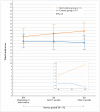Modification in the Motor Skills of Seniors in Care Homes Using Serious Games and the Impact of COVID-19: Field Study
- PMID: 35536610
- PMCID: PMC9094716
- DOI: 10.2196/36768
Modification in the Motor Skills of Seniors in Care Homes Using Serious Games and the Impact of COVID-19: Field Study
Abstract
Background: The pandemic has highlighted the importance of low-threshold opportunities for exercise and physical activity. At the beginning of 2020, the COVID-19 pandemic led to many restrictions, which affected seniors in care facilities in the form of severe isolation. The isolation led, among other things, to a lack of exercise, which has led to a multitude of negative effects for this target group. Serious games can potentially help by being used anywhere at any time to strengthen skills with few resources.
Objective: The aim of this study is to evaluate the effectiveness of a serious game to strengthen motor skills (study 1) and the influence of pandemic restrictions (study 2) on seniors in care facilities.
Methods: The data on motor skills (measured by the Tinetti test) originated from an intervention study with repeated measurements that was interrupted by the pandemic conditions. Data were collected 4 times every 3 months with an intervention group (IG, training 3 times for 1 hour per week) and a control group (CG, no intervention). There were 2 substudies. The first considered the first 6 months until the pandemic restrictions, while the second considered the influence of the restrictions on motor skills.
Results: The sample size was 70. The IG comprised 31 (44%) participants, with 22 (71%) female and 9 (29%) male seniors with an average age of 85 years. The CG comprised 39 (56%) participants, with 31 (79%) female and 8 (21%) male seniors with an average age of 87 years. In study 1, mixed-design ANOVA showed no significant interaction between measurement times and group membership for the first measurements (F2.136=1.414, P<.25, partial η2=.044), but there was a significant difference between the CG (mean 16.23, SD 1.1) and the IG (mean 19.81, SD 1.2) at the third time of measurement (P=.02). In study 2 the mixed-design ANOVA (used to investigate motor skills before and after the pandemic conditions between the 2 groups) couldn't reveal any significant interaction between measurement times and group membership: F1.67=2.997, P<.09, partial η2=.043. However, there was a significant main effect of the time of measurement: F1.67=5.44, P<.02, partial η²=.075.
Conclusions: During the first 6 months, the IG showed increased motor skills, whereas the motor skills of the CG slightly deteriorated and showed a statistically significant difference after 6 months. The pandemic restrictions leveled the difference and showed a significant negative effect on motor skills over 3 months. As our results show, digital games have the potential to break down access barriers and promote necessary maintenance for important skills. The pandemic has highlighted the importance of low-threshold opportunities for exercise and physical activity. This potentially great benefit for the challenges of tomorrow shows the relevance of the topic and demonstrates the urgent need for action and research.
Trial registration: Deutsches Register klinischer Studien DRKS00016633; https://tinyurl.com/yckmj4px.
Keywords: COVID-19; aged; care home; coronavirus effects; digital game; digital health; eHealth; elder; exercise; intervention effects analysis; long-term care; motor; motor skills; movement; older adult; pandemic; physical activity; senior population; seniors; serious games.
©Jana Marina Kleschnitzki, Inga Grossmann, Reinhard Beyer, Luzi Beyer. Originally published in JMIR Serious Games (https://games.jmir.org), 10.05.2022.
Conflict of interest statement
Conflicts of Interest: None declared.
Figures




Similar articles
-
The Effectiveness of a Serious Game (MemoreBox) for Cognitive Functioning Among Seniors in Care Facilities: Field Study.JMIR Serious Games. 2022 Apr 1;10(2):e33169. doi: 10.2196/33169. JMIR Serious Games. 2022. PMID: 35172959 Free PMC article.
-
COVID-19 as 'Game Changer' for the Physical Activity and Mental Well-Being of Augmented Reality Game Players During the Pandemic: Mixed Methods Survey Study.J Med Internet Res. 2020 Dec 22;22(12):e25117. doi: 10.2196/25117. J Med Internet Res. 2020. PMID: 33284781 Free PMC article.
-
Behavioural interventions for urinary incontinence in community-dwelling seniors: an evidence-based analysis.Ont Health Technol Assess Ser. 2008;8(3):1-52. Epub 2008 Oct 1. Ont Health Technol Assess Ser. 2008. PMID: 23074508 Free PMC article.
-
Impact of summer programmes on the outcomes of disadvantaged or 'at risk' young people: A systematic review.Campbell Syst Rev. 2024 Jun 13;20(2):e1406. doi: 10.1002/cl2.1406. eCollection 2024 Jun. Campbell Syst Rev. 2024. PMID: 38873396 Free PMC article. Review.
-
Behavioural modification interventions for medically unexplained symptoms in primary care: systematic reviews and economic evaluation.Health Technol Assess. 2020 Sep;24(46):1-490. doi: 10.3310/hta24460. Health Technol Assess. 2020. PMID: 32975190 Free PMC article.
Cited by
-
THE EFFECTS OF RESTRICTIONS DURING THE COVID-19 PANDEMIC ON PHYSICAL ACTIVITY AND MENTAL HEALTH OF THE ELDERLY.Acta Clin Croat. 2024 Apr;63(1):175-184. doi: 10.20471/acc.2024.63.01.21. Acta Clin Croat. 2024. PMID: 39959319 Free PMC article. Review.
-
Interactive Somatosensory Games in Rehabilitation Training for Older Adults With Mild Cognitive Impairment: Usability Study.JMIR Serious Games. 2022 Jul 14;10(3):e38465. doi: 10.2196/38465. JMIR Serious Games. 2022. PMID: 35834303 Free PMC article.
References
-
- Witt K. Ausgewählte Themen der Sportmotorik für das weiterführende Studium (Band 2) Switzerland: Springer Nature; 2018.
-
- Centre for Evidence-Based Medicine Global COVID-19 Case Fatality Rates. [2022-05-03]. https://www.cebm.net/covid-19/global-covid-19-case-fatality-rates/
-
- Tiemann M, Mohokum M. Demografischer Wandel, Krankheitspanorama, Multimorbidität und Mortalität in Deutschland. Springer Reference Pflege - Therapie - Gesundheit. 2021:3–11. doi: 10.1007/978-3-662-62426-5_1. - DOI
-
- Lebrasseur A, Fortin-Bédard N, Lettre J, Raymond E, Bussières E-L, Lapierre N, Faieta J, Vincent C, Duchesne L, Ouellet M, Gagnon E, Tourigny A, Lamontagne M, Routhier F. Impact of the COVID-19 pandemic on older adults: rapid review. JMIR Aging. 2021 Apr 12;4(2):e26474. doi: 10.2196/26474. https://aging.jmir.org/2021/2/e26474/ v4i2e26474 - DOI - PMC - PubMed
-
- Visser M, Schaap LA, Wijnhoven HAH. Self-reported impact of the COVID-19 pandemic on nutrition and physical activity behaviour in Dutch older adults living independently. Nutrients. 2020 Nov 30;12(12):3708. doi: 10.3390/nu12123708. https://www.mdpi.com/resolver?pii=nu12123708 nu12123708 - DOI - PMC - PubMed
LinkOut - more resources
Full Text Sources
Research Materials
Miscellaneous

